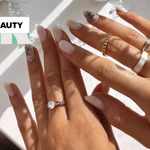Let’s face it – even if you adore your usual hairstyles, you’re bound to get bored at some point. And when boredom strikes, you might want to try something new and fresh, which you can easily achieve by curling your wig.
Curling your wig is a great way to achieve a cute new style at little to no cost. But if you care about your wig, you likely want to avoid frying it with hot tools. Fortunately, despite what some folks think, it’s completely possible to curl any type of wig, synthetic or human hair, without causing any heat damage. No more fried ends, breakage, or melted hair!
Safely and responsibly curl any type of wig without heat damage by following a few tips.

Brush first.
First, brush your hair with a wig brush or wide-tooth comb to remove any tangles. This ensures that you’ll get a nice, smooth curl without any snags, which can cause breakage.
Use a heat protectant.
If you’re curling a human hair wig, it’s generally safe to apply heat. Still, you don’t want to fry the hair or damage it over time.
To protect the strands, apply a heat protectant spray and distribute it evenly throughout each section of hair before applying heat. This won’t turn your hair into Superman, mind you – you can still fry your hair, even after applying a heat protectant. But, these sprays do serve as the first line of defense against damage.
Never heat-style wet hair.
Wet hair is much, much more vulnerable to heat damage than dry hair. Applying hot tools to wet or damp hair is just asking for fried, burned hair. Always wait until your hair is 100% dry before applying heat.
Check the label for synthetic hair.
Yes, it is possible to curl a synthetic wig. But you should never attempt to use hot tools, like a curling iron, on a synthetic wig – unless the label specifically says that the wig can tolerate heat. If not, you can use foam rollers to curl the wig using the method below.
Use rollers.
Rollers, curling irons, dowels, and flat-irons can all be used to create a curl in the hair. Rollers, however, are the easiest way to create a curl without applying too much (or any!) heat to the hair.
Simply place the roller at the end of the strand and wind the hair around it, rolling the roller and hair toward the base of the wig.
If your wig is synthetic, allow the hair to fully air dry before removing the rollers, then apply a styling spray. If your wig is human hair, use a blow dryer on each roller for no longer than 60 seconds.
Start with low heat.
If you use a hot tool, like a curling iron or flat iron, to curl your hair, make sure to start with a lower temperature. The temperature should be just high enough to create a curl. For a curling iron, 180 degrees Fahrenheit is a good starting point. For a flat-iron, 250 degrees Fahrenheit should work.
Do a heat test.
Additionally, you should do a heat test on a less-visible part of the wig if you’re worried about the heat damaging the strands. Try using a patch on the base of the neck or in an under-layer of the hair. If that goes well, you can move forward with the rest of the wig.
Don’t apply heat for too long.
If you’re using a blow dryer, aim it onto each section of hair for no longer than 60 seconds at a time. The longer you apply heat, the more damage you can cause!
If you’re using a curling iron or flat iron, never let the hair stay sitting on the source of heat. Hold the hair to the iron for as long as it takes to create a curl – up to 10 seconds with a curling iron – and then remove it.
Apply hairspray.
Another great way to avoid heat damage? Getting things right the first time so that you don’t have to keep re-curling the hair over and over! To keep your curls for longer, pin each curl into place against your head and apply plenty of hair spray to hold the style.
What are your favorite tips and tricks to avoid heat damage when curling your wigs or hair?
Looking for wigs to curl or a pre-curled wig? Check out our collection of Human Hair Wigs!











